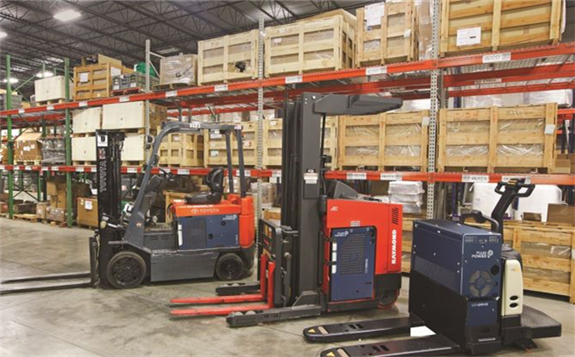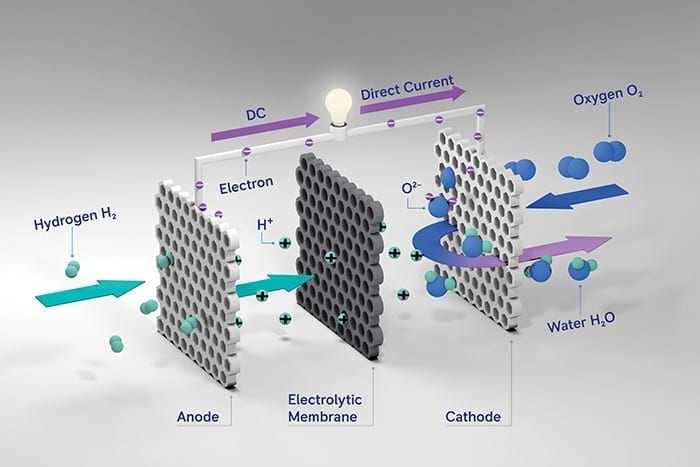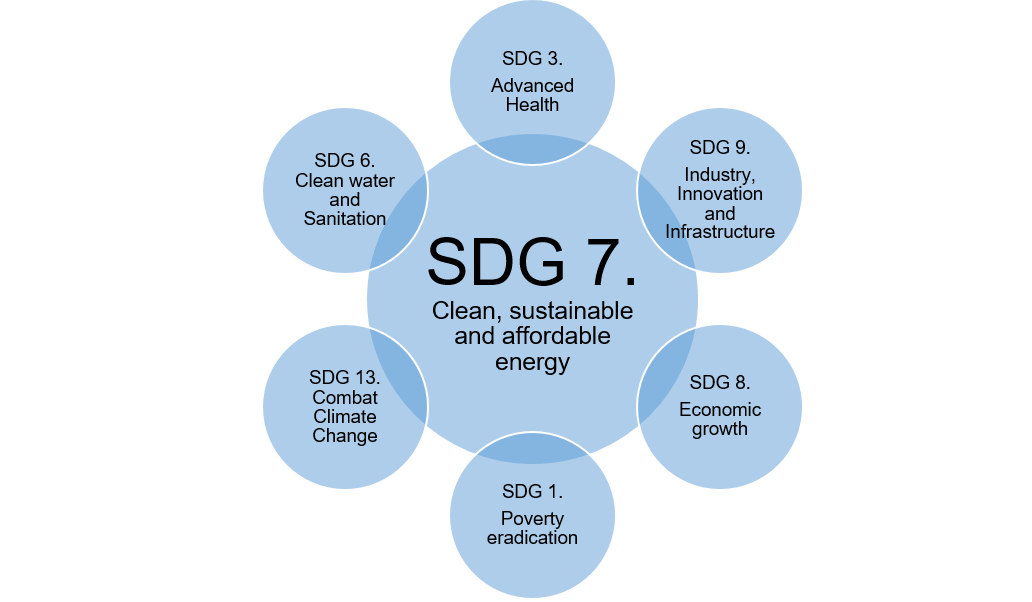 Plug Power wants to build green hydrogen production sites and a fuel cell and electrolyzer 'gigafactory' to support the shift to carbon-free power. (Credit: Plug Power)
Plug Power wants to build green hydrogen production sites and a fuel cell and electrolyzer 'gigafactory' to support the shift to carbon-free power. (Credit: Plug Power)
Plug Power has raised about $1 billion in a bought equity transaction to fund its plan to build what could be the first U.S.-wide network of green hydrogen production facilities to supply fuel-cell-powered vehicles, including its own, with carbon-free fuel.
The Latham, New York-based company, already the country’s largest user of hydrogen to fuel forklifts and other working vehicles using its fuel cells, also intends to build a gigafactory to expand production of fuel cells and electrolyzers, spurring a phone call last week from U.S. Senator Chuck Schumer (D-New York) to the company asking it to site the factory in his home state.
Tuesday’s sale of about 43.7 million shares via an underwriting agreement with Morgan Stanley brings Plug Power’s total cash post-closing balance to $1.7 billion. “The capital raise uniquely positions Plug Power to execute and accelerate on its green hydrogen strategy as well as other strategic growth initiatives,” the company said in a prepared statement.
“We plan to build five green hydrogen stations across North America, using 100 tons of hydrogen a day. The source for that will be renewables, solar, wind [and] hydroelectric power,” Andy Marsh said in an October press conference featuring oil companies, automakers, hydrogen producers and other companies promoting investment in U.S. green hydrogen infrastructure.
Plug Power, founded in 1997, supplies fuel cells for forklifts operating in warehouses of some of the country’s biggest companies, including Amazon, Walmart, DHL and Home Depot. Fuel cells have outpaced battery-powered vehicles in these settings, largely because they can be refueled more quickly and keep running longer.
The company already uses about 20 tons of liquid hydrogen per day to fuel about 40,000 forklifts now in use, but it expects it will need to add 85 tons per day of production capacity if it’s to reach its stated goal of 25,000 units a year and $1.2 billion in annual sales by 2024.
Plug Power’s plans for U.S. green hydrogen development
While Plug Power’s proton exchange membrane fuel cells convert hydrogen to electricity and water without any carbon emissions, the same can’t be said of the sources of hydrogen it’s using to fuel them. The vast majority of hydrogen production today, in the U.S. and around the world, comes from steam reforming of natural gas, which carries a significant carbon emissions footprint.
Using electricity from renewable sources like solar and wind farms to electrolyze water into hydrogen offers a carbon-free alternative. In September, Plug Power announced partnerships with Apex Clean Energy and Brookfield Renewable Partners to secure renewable energy to power its planned green hydrogen production facilities. It hopes to secure additional clean power sources to open its first two green hydrogen facilities by 2022 and have all five operational by 2024.
Green hydrogen costs three to four times as much to produce as the dominant “gray hydrogen” alternative, although large-scale investments in Europe and Asia could bring it within cost parity by 2030, according to multiple analyses. This will require significant cost reductions in clean power supply, cost reductions and efficiency improvements in electrolyzer technologies, and economies of scale in production, transport and consumption to achieve.
The U.S. lags behind Europe and Japan in public investment in green hydrogen, but several large-scale efforts have been launched to develop production capacity for use in electricity generation. Utilities in Utah, California and the U.S. Gulf Coast have laid plans to convert coal- and natural-gas-fired power plants to run on hydrogen and to develop the electrolysis, storage and transport capacity to make it available for broader uses.
Hydrogen-fueled vehicles lag behind battery-powered electric vehicles in widespread adoption and infrastructure to support them, and it’s unclear if fuel cells will be cost-competitive with batteries for passenger vehicles over the long run. But hydrogen may be a more suitable choice for long-haul trucks or heavy-duty vehicles, proponents of fuel cells argue.
Plug Power is seeking to expand from forklifts to heavy-duty vehicles to serve ports in the U.S. and Europe, as well as stationary fuel cells to power data centers and distribution hubs.
Sanjay Shrestha, Plug Power’s chief strategy officer and head of its green hydrogen generation business, said in Tuesday’s statement that the company has “identified several locations working with strategic partners where we can produce green hydrogen at parity with gray hydrogen and see further opportunities to reduce the cost of green hydrogen.”
Plug Power’s proposed gigafactory, expected to open in 2021, will expand its current fuel-cell production capacity at facilities in Clifton Park and Rochester, N.Y. and Spokane, Washington. By 2024, Plug Power intends to be producing about 1.5 gigawatts of fuel cells and about 500 megawatts of electrolyzers per year.
The company stated this month that it is in “continuing negotiations with two state governments” to pick the gigafactory’s location, with equipment already ordered and scheduled for opening on track.
Sen. Schumer’s office noted in a press release last week that New York is eager to host the facility, which is expected to employ about 300 people and serve as a center for fuel cell and green hydrogen research and development.
This article is reproduced at www.greentechmedia.com



